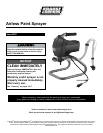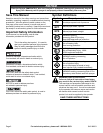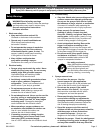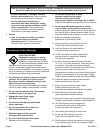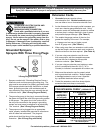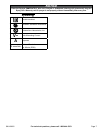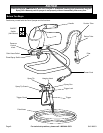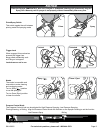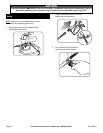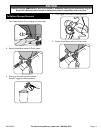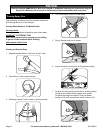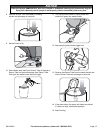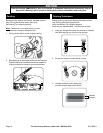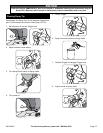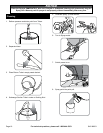
Page 5For technical questions, please call 1-800-444-3353.SKU 68001
NOTICE
Clean the Sprayer IMMEDIATELY after use. Delayed or inadequate cleaning will permanently clog the
Spray Gun. Warranty void if sprayer is not properly cleaned immediately after every use.
24. Remove Spray Tip or turn to cleaning position
BEFORE cleaning or ushing Paint Sprayer system.
25. Do not use pliers to tighten or loosen
high pressure connections.
26.
Sparks from improper grounding
can ignite fumes!
Follow all local regulations regarding the
use of uid supply containers and solvent
pails used with ushing the Paint Sprayer.
Use only conductive metal pails placed on a grounded
(concrete) surface. Do not place pails on
nonconductive surfaces (such as cardboard or paper).
Ground all metal pails by clamping one end of a ground
wire to the pail and the other end to a
grounded structure (such as a nearby pipe).
Maintain grounding, even when ushing or relieving
pressure from Paint Sprayer into metal pail.
The force of the spray can knock a metal pail over,
so hold down the metal pail and keep the metal part of
the spray gun set against the grounded metal pail when
pressing the spray gun trigger.
27. Maintain labels and nameplates on the sprayer.
These carry important safety information.
If unreadable or missing,
contact Harbor Freight Tools for a replacement.
28. Avoid unintentional starting. Prepare to begin work
before turning on the sprayer.
29. This product is not a toy.
Keep it out of reach of children.
30. People with pacemakers should consult their
physician(s) before use. Electromagnetic elds in
close proximity to heart pacemaker could cause
pacemaker interference or pacemaker failure.
31. WARNING: Some dust created by power
sanding, sawing, grinding, drilling, and other
construction activities, contains chemicals known
[to the State of California] to cause cancer,
birth defects or other reproductive harm.
Some examples of these chemicals are:
• Lead from lead-based paints
• Crystalline silica from bricks and cement or
other masonry products
• Arsenic and chromium from chemically treated lumber
Your risk from these exposures varies,
depending on how often you do this type of work.
To reduce your exposure to these chemicals:
work in a well ventilated area, and work with approved
safety equipment, such as those dust masks that are
specially designed to lter out microscopic particles.
(California Health & Safety Code § 25249.5, et seq.)
32. WARNING: Handling the cord on this product will
expose you to lead, a chemical known to the State
of California to cause cancer, and birth defects or
other reproductive harm. Wash hands after handling.
(California Health & Safety Code § 25249.5, et seq.)
SAVE THESE
INSTRUCTIONS.



